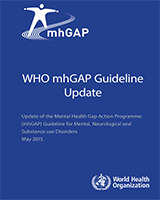Excerpt
Mental, neurological, and substance use (MNS) disorders are prevalent in all regions of the world and are major contributors to morbidity and premature mortality. In 2008, the World Health Organization (WHO) developed the Mental Health Gap Action Programme (mhGAP), to facilitate scaling up of care for MNS disorders. A key part of mhGAP is the evidence-based guideline, published in 2010 and available through the mhGAP Evidence Resource Centre (http://www.who.int/mental health/mhgap/evidence/en/). The objectives of the guideline are:
To provide up-to-date WHO guidance to facilitate delivery of interventions by non-specialist health care providers in low- and middle-income countries (LAMICs);
To assist with the scale up of care for MNS disorders identified as conditions of high priority in LAMICs, specifically: depression, psychosis (including schizophrenia and bipolar disorders), epilepsy, child mental disorders, dementia, alcohol use disorders, drug use disorders and self-harm/suicide;
To provide up-to-date WHO guidance that will facilitate the implementation of the WHO Comprehensive Mental Health Action Plan 2013-2020 by health care planners and programme managers in LAMICs.
The designations employed and the presentation of the material in this publication do not imply the expression of any opinion whatsoever on the part of the World Health Organization concerning the legal status of any country, territory, city or area or of its authorities, or concerning the delimitation of its frontiers or boundaries. Dotted lines on maps represent approximate border lines for which there may not yet be full agreement.
The mention of specific companies or of certain manufacturers' products does not imply that they are endorsed or recommended by the World Health Organization in preference to others of a similar nature that are not mentioned. Errors and omissions excepted, the names of proprietary products are distinguished by initial capital letters.
All reasonable precautions have been taken by the World Health Organization to verify the information contained in this publication. However, the published material is being distributed without warranty of any kind, either expressed or implied. The responsibility for the interpretation and use of the material lies with the reader. In no event shall the World Health Organization be liable for damages arising from its use.

